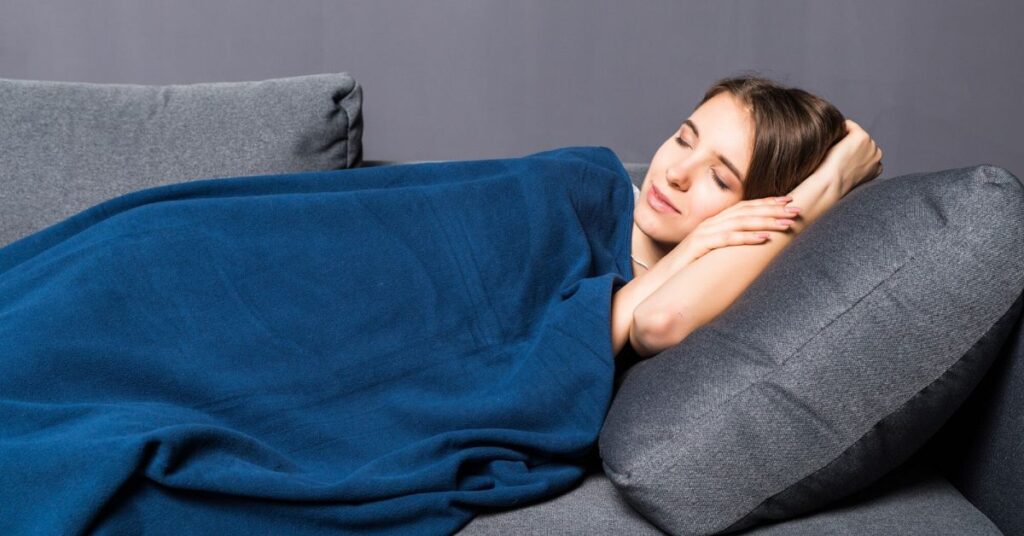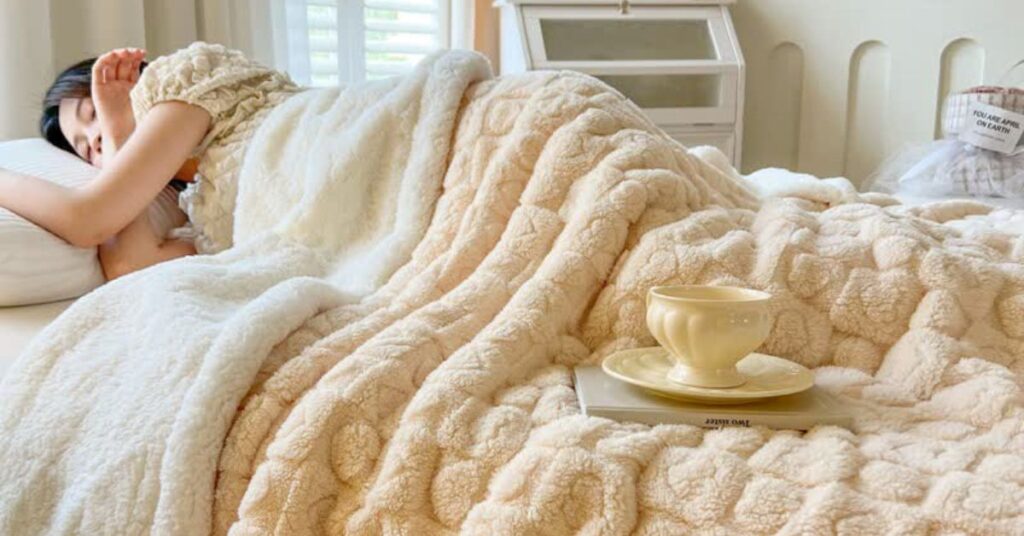When searching for what is the softest blanket material, options like cashmere, microfiber, and fleece often come to mind. Each material offers a unique blend of softness, warmth, and comfort, making it essential to find the perfect match for your needs.
At Yes That Blanket, we explore the best blanket materials to help you choose the ultimate cozy companion. Cashmere is known for its luxurious feel, while microfiber provides a plush yet lightweight texture. Fleece delivers exceptional warmth, and bamboo or silk stands out for its naturally smooth touch. Understanding the qualities of these materials can guide you to the softest, coziest blanket for maximum comfort.
Key Takeaways
- Cashmere blankets are renowned for their luxurious softness and elegant feel from natural goat fibers.
- Microfiber blankets offer unique softness with tightly woven synthetic fibers mimicking natural softness.
- Fleece blankets provide exceptional softness and warmth with a high warmth-to-weight ratio.
- Silk blankets are smooth and provide luxury with their natural protein fiber composition.
- Sherpa blankets offer plush texture and excellent warmth with high-pile polyester fibers.
Fleece Blankets
Fleece blankets are frequently sought after for their exceptional warmth and softness, making them a popular choice for those wanting cozy comfort. Fleece fabric, a synthetic textile, is crafted from polyester fibers, which are brushed to create a plush nap that traps warmth effectively. You’ll appreciate its lightweight nature, which doesn’t compromise on insulation, providing a warmth-to-weight ratio that’s hard to beat. The structure of fleece fabric allows for excellent breathability, guaranteeing you don’t overheat, even when layered during colder months.
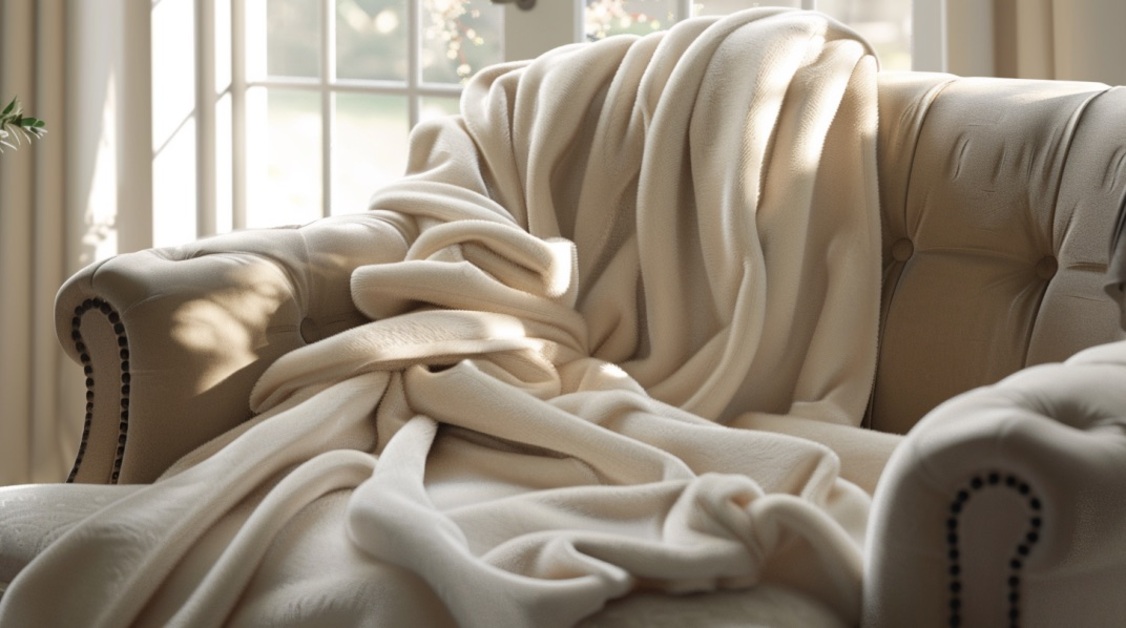
Fleece blanket fabric
One of the standout features of fleece blankets is fleece durability. Despite their soft texture, these blankets are remarkably resilient. The synthetic fibers of fleece fabric resist pilling and retain their shape and softness through countless washes, making them a long-lasting addition to your home. Fleece’s hydrophobic properties mean it dries quickly after washing, maintaining its form and function with minimal effort. Additionally, the fabric’s ability to wick moisture away from the body enhances comfort, particularly in humid conditions.
When you choose a fleece blanket, you’re selecting a material engineered for performance and comfort, combining advanced textile technology with everyday practicality. This blend of features guarantees your fleece blanket remains a cozy staple.
Read More: How to Wash a Fleece Blanket: Secrets for a Fresh and Fluffy Finish!
Cashmere Blankets
While fleece blankets offer modern versatility, cashmere blankets bring timeless elegance and unparalleled luxury to your collection. Crafted from the fine undercoat fibers of cashmere goats, these blankets boast a softness that is both natural and exquisite. The fibers are exceptionally lightweight yet remarkably insulating, providing warmth without the weight. Cashmere’s natural crimp enhances its softness, making it ideal for those who appreciate a gentle touch and superior comfort.

Cashmere blanket fabric
Cashmere care is essential to maintain its luxurious feel and appearance. Hand washing in cold water with a mild detergent, followed by air drying flat, preserves the fabric’s integrity. Avoid wringing or twisting the material to prevent damage. For long-lasting cashmere durability, store your blanket in a cool, dry place, preferably in a breathable cotton bag, to protect it from moths and moisture.
When considering cashmere durability, it is crucial to recognize its resistance to pilling, though some minimal pilling is natural. Gently removing these pills with a cashmere comb will help maintain the blanket’s pristine condition. Investing in a cashmere blanket means choosing a piece that combines elegance, warmth, and resilience, elevating your home’s comfort and style.
Microfiber Blankets
You’ll find microfiber blankets offer a unique combination of softness and durability, thanks to their tightly woven synthetic fibers that trap warmth while remaining lightweight. To maintain their plush texture and vibrancy, wash them in cold water using a gentle detergent and avoid high heat during drying, which can damage the fibers. These blankets are hypoallergenic and resistant to dust mites, making them an excellent choice for those with allergies.
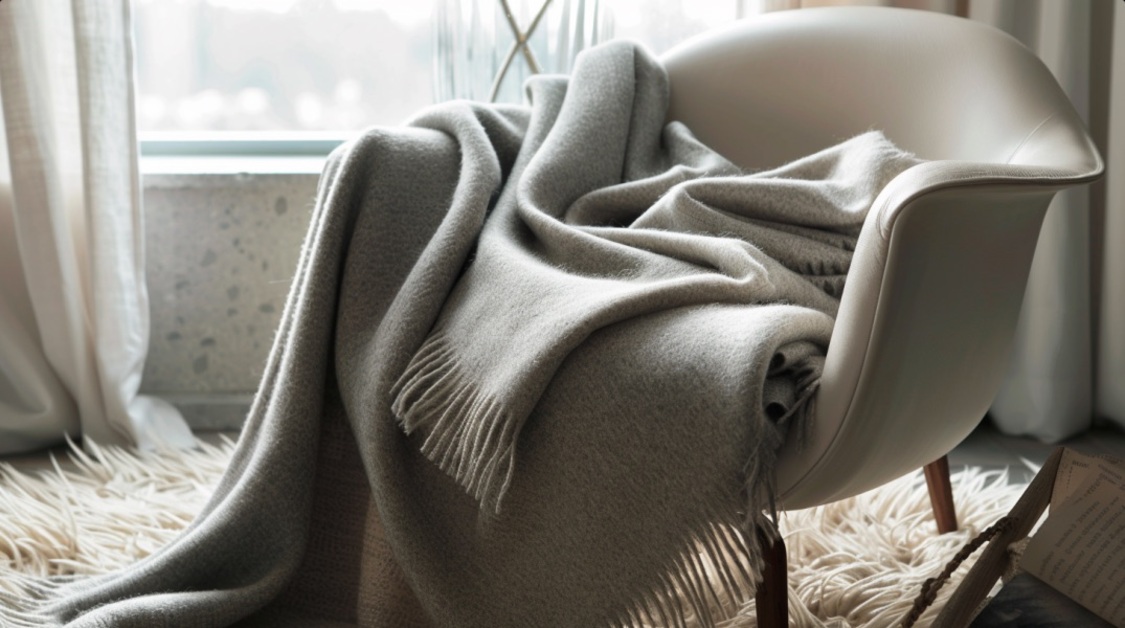
Microfiber blanket fabric
Benefits of Microfiber Blankets
Microfiber blankets offer a range of benefits that make them a popular choice for many households. One of the standout features is their microfiber versatility. Made from ultra-fine synthetic fibers, these blankets can be engineered to mimic the softness of natural fibers while providing enhanced durability. This versatility means they can be used in various settings, from cozying up on the couch to adding a layer of warmth on your bed.
Another significant advantage is microfiber breathability. Despite their dense construction, microfiber blankets allow for efficient airflow, effectively regulating your body temperature. This breathability guarantees you stay warm without overheating, providing comfort throughout the night. The tightly woven fibers also contribute to their hypoallergenic properties, reducing the risk of allergens like dust mites.
Additionally, microfiber blankets are highly resistant to moisture. They effectively wick away sweat and other moisture, keeping you dry and comfortable. The material’s ability to resist stains also means that these blankets maintain their appearance longer, adding to their appeal. Lightweight yet robust, microfiber blankets are easy to fold and store, making them an excellent choice for those who value both practicality and comfort in their bedding options.
Care and Maintenance Tips
Maintaining the quality and longevity of your microfiber blankets requires a few key steps. First, understand microfiber’s unique fabric care needs. It’s essential to wash them separately to prevent lint transfer, as microfiber’s electrostatic properties attract particles. Always use a gentle detergent that’s free from additives like fabric softeners, which can coat fibers and reduce softness.
When it comes to washing techniques, opt for cold water setting on a gentle cycle to minimize fiber agitation. This approach preserves the blanket’s plush texture and prevents pilling. Avoid bleach, as it can degrade the synthetic fibers, leading to a loss of durability. Additionally, refrain from using high heat in the dryer. Instead, tumble dry on low or air dry to maintain the blanket’s structural integrity and softness.
Storage also plays a role in fabric care. Keep your microfiber blankets in a dry, cool environment to prevent moisture buildup, which can cause mildew. Fold them neatly to avoid creases that could damage fibers over time. By following these precise washing techniques and storage guidelines, you’ll guarantee your microfiber blankets remain a soft, cozy staple in your home for years to come.
Sherpa Blankets
Sherpa blankets offer a plush texture experience, providing a tactile sensation akin to genuine fleece, thanks to their high-pile polyester fibers. You’ll find that these blankets excel in warmth and insulation, effectively trapping heat due to their dense construction, making them ideal for colder climates. Additionally, their easy maintenance care involves simple machine washing and quick drying, ensuring both convenience and longevity.
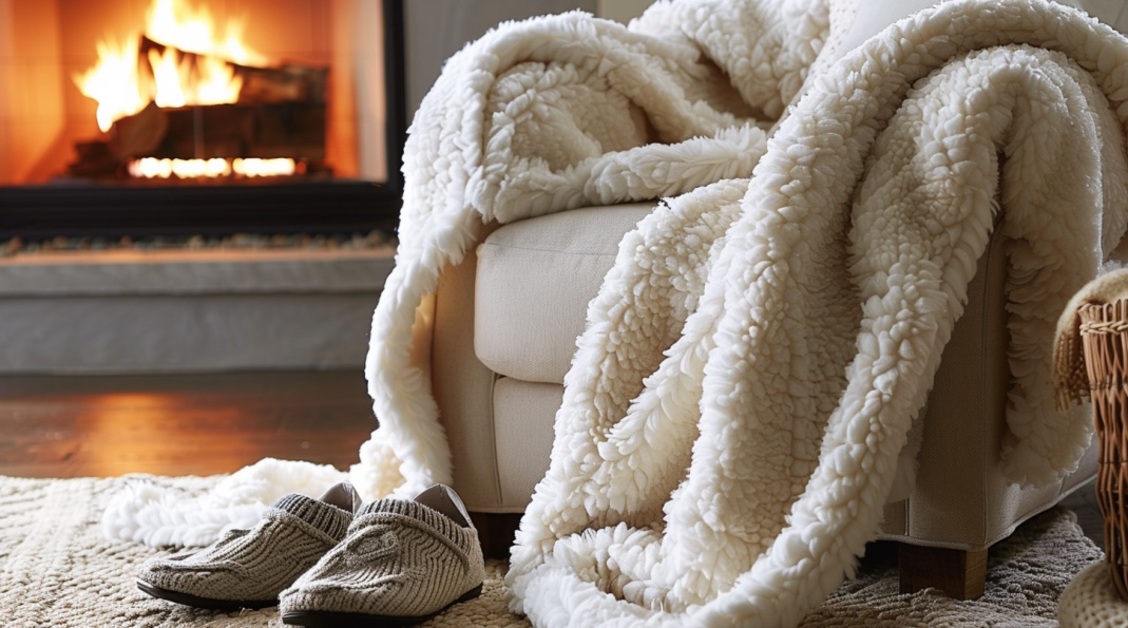
Sherpa blanket fabric
Plush Texture Experience
Often celebrated for their luxurious feel, Sherpa blankets offer a plush texture experience that’s both inviting and functional. When you run your fingers across a Sherpa blanket, you’ll notice the dense, fluffy surface, resembling the soft fleece found on sheep. This texture is achieved through synthetic fibers like polyester, which are meticulously woven to mimic natural wool. The plush benefits of Sherpa blankets are evident in their ability to provide exceptional comfort without compromising on durability. They’re designed to be resistant to pilling and stretching, ensuring longevity while maintaining their soft appeal.
When considering plush alternatives, it is crucial to understand how Sherpa blankets stand out. Unlike microfleece, which can be thinner, Sherpa provides a more substantial and tactile experience. The dual-sided design, with a smooth outer layer and a fluffy interior, offers versatility in use, enhancing the plush texture experience.
This makes the Sherpa blanket an ideal choice for those seeking both aesthetic appeal and functional comfort. Additionally, the hypoallergenic properties of the synthetic fibers make Sherpa blankets a suitable option for individuals with sensitive skin, adding to their allure. By choosing Sherpa, you’re opting for a blanket that delivers superior softness and practicality.
Warmth and Insulation
Ever wondered why Sherpa blankets are your go-to choice for warmth and insulation? It’s all about their exceptional insulation properties. Sherpa blankets are crafted with a unique synthetic blend that mimics the soft, fluffy texture of natural wool. This comfortable material excels in warmth retention, effectively trapping body heat, which keeps you cozy during those chilly nights. The plush fibers create numerous tiny air pockets that function as insulators, reducing heat loss and maintaining a consistently warm environment.
The structure of Sherpa fabric is designed to be lightweight yet incredibly efficient in providing thermal insulation. Unlike other materials, Sherpa’s dual-layer construction offers an outer layer that repels cold air while the inner fleece-like layer keeps warmth close to your skin. This dual-layer system not only boosts their warmth retention capabilities but also enhances their durability and comfort.
Moreover, Sherpa blankets are highly breathable, allowing moisture to escape without compromising warmth. This breathability prevents overheating, ensuring that you remain comfortable regardless of fluctuations in temperature. When you choose a Sherpa blanket, you’re not just getting softness but a scientifically designed solution for peak warmth and insulation.
Easy Maintenance Care
Maintaining the pristine condition of your Sherpa blankets is remarkably straightforward, thanks to their durable construction and resilient materials. Understanding the nuances of fabric care and blanket washing guarantees longevity while preserving that soft, plush feel. Sherpa blankets, with their synthetic fibers, are designed for easy maintenance. Here’s how you can keep your Sherpa blanket in top shape:
- Washing: Use a gentle cycle with cold water. Hot water can cause fibers to lose their softness and structure. A mild detergent will effectively clean without harsh chemicals.
- Drying: Air drying is ideal. If you use a dryer, opt for the lowest heat setting to prevent any potential shrinkage or damage to the fibers.
- Avoid Fabric Softeners: These can coat the fibers, reducing the blanket’s natural softness and breathability. Instead, use a vinegar rinse to keep fibers soft.
- Spot Cleaning: Immediately address spills with a damp cloth and mild detergent. This prevents stains from setting, maintaining the blanket’s aesthetic.
Bamboo Blankets
When it comes to choosing the softest blanket material, bamboo blankets stand out due to their unique combination of breathability and moisture-wicking properties. Bamboo fibers offer significant benefits, making them a popular choice for those seeking comfort and sustainability. Derived from an eco-friendly source, bamboo is a rapidly renewable resource, requiring minimal water and no pesticides during cultivation. This contributes to its reputation as an eco-friendly material, perfect for environmentally-conscious consumers.
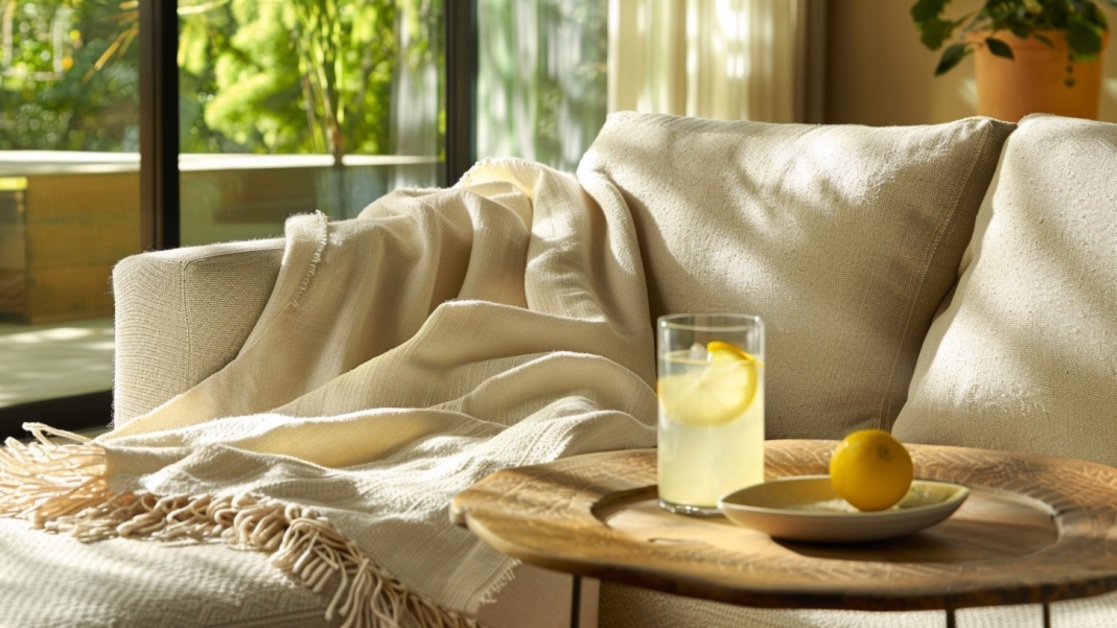
Bamboo blanket fabric
Bamboo blankets excel in regulating temperature, keeping you cool in the summer and warm in the winter. Thanks to their moisture-wicking capabilities, they effectively draw sweat away from your skin, preventing clamminess during sleep. The fibers are naturally hypoallergenic, reducing the likelihood of allergic reactions and making them ideal for sensitive skin.
Additionally, bamboo fibers possess antimicrobial properties, inhibiting the growth of bacteria and ensuring your blanket remains fresh and odor-free. This not only enhances its longevity but also reduces the frequency of washing, conserving water and energy. The silky-smooth texture of bamboo blankets provides an unparalleled softness, enveloping you in comfort and luxury. Whether you’re lounging on the couch or drifting off to sleep, a bamboo blanket promises a soothing experience.
Chenille Blankets
When you experience a chenille blanket, you’ll notice its luxurious fabric texture characterized by a velvety, plush surface that offers exceptional tactile comfort. This material provides excellent warmth and insulation due to its unique pile construction, trapping heat effectively to keep you cozy in colder environments. Additionally, chenille blankets boast remarkable durability but require specific maintenance practices such as gentle washing and low-heat drying to preserve their soft fibers and prevent wear over time.
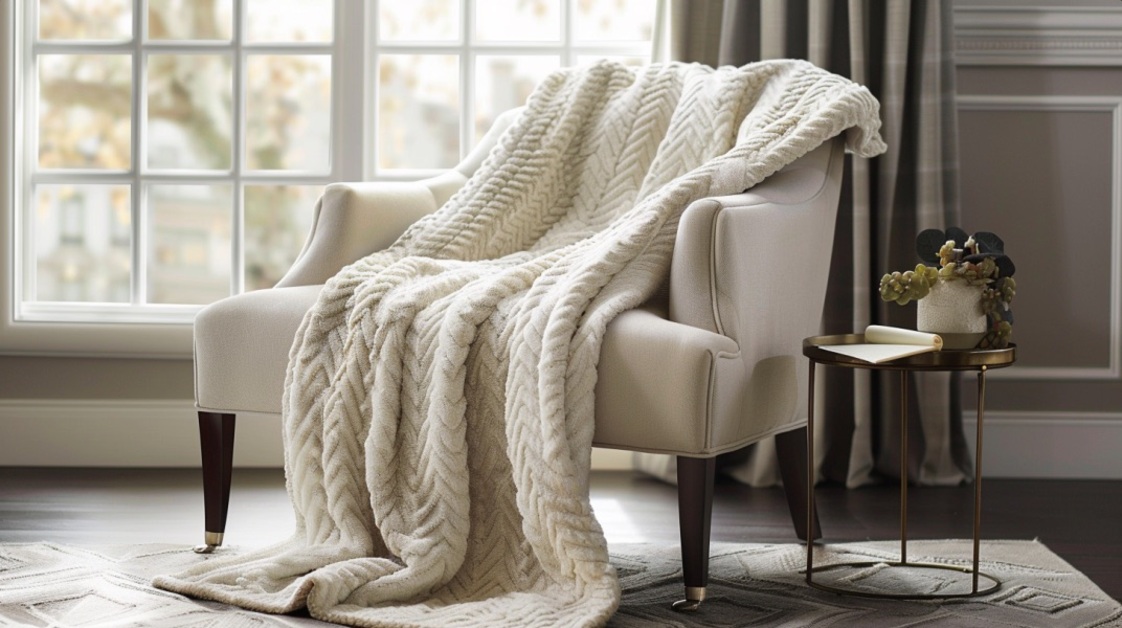
Chenille blanket fabric
Luxurious Fabric Texture
Among the myriad of luxurious fabrics, chenille blankets stand out due to their unique texture and unparalleled softness. This fabric type is renowned for its plush, velvety feel, achieved through a specialized weaving technique. Chenille, derived from the French word for “caterpillar,” reflects the characteristic fuzziness of the fabric. It’s this luxury softness that makes chenille a favorite choice for those seeking the epitome of comfort.
To fully appreciate chenille blankets, consider these features:
- Fabric Construction: Chenille is crafted using short lengths of yarn, known as pile, wrapped around a core. This creates a raised, tufted surface that feels incredibly soft against the skin.
- Visual Appeal: The fabric’s iridescent sheen is due to the way light interacts with its fibers, giving it a shimmering appearance that enhances any room’s decor.
- Durability: Despite its delicate appearance, chenille is a robust fabric type. It’s tightly woven, ensuring the blanket maintains its shape and texture over time.
- Versatility: Available in various colors and patterns, chenille blankets can complement a wide range of interior designs, making them a versatile addition to any home.
Warmth and Insulation
For those seeking the ultimate in cozy warmth, chenille blankets offer exceptional insulation thanks to their unique fabric structure. The term “chenille” refers to the yarn’s caterpillar-like appearance, characterized by its tufted, velvety texture. This structure contributes considerably to the blanket’s thermal properties.
The fibers in chenille are densely packed, creating numerous tiny air pockets that trap heat effectively. This configuration enhances insulation effectiveness by minimizing heat transfer, making chenille blankets an excellent choice for maintaining warmth in cooler environments.
When you wrap yourself in a chenille blanket, you’ll experience its remarkable thermal properties firsthand. The fabric’s plush surface not only feels luxurious but also serves as a superb barrier against the cold.
Its high insulation effectiveness is attributed to the pile’s ability to regulate temperature, ensuring you remain comfortably warm without overheating. As chenille fibers are often made from materials like cotton, acrylic, or rayon, they blend durability with incredible softness, further augmenting their insulating capabilities.
In essence, chenille blankets are engineered for ideal warmth retention. By enveloping you in their dense, velvety layers, they provide a cozy cocoon, ideal for snuggling up during chilly nights or simply enjoying a relaxing, warm embrace.
Durability and Maintenance
How do you guarantee that your chenille blanket remains as lush and inviting as the day you bought it? Paying close attention to durability factors and maintenance practices is essential. Chenille blankets, with their plush texture, require specific care to maintain their softness and structural integrity.
For best results, follow these steps:
- Washing Instructions: Always use cold water and a gentle cycle. Hot water and aggressive agitation can damage the delicate fibers, reducing durability.
- Drying Protocol: Air-drying is preferred to avoid heat damage. If you must use a dryer, opt for a low heat setting to preserve the blanket’s texture and prevent shrinkage.
- Storage Solutions: Store your chenille blanket in a cool, dry place. Avoid plastic bags that trap moisture, which can lead to mildew and fiber breakdown.
- Spot Cleaning Techniques: For spills, use a mild detergent and dab gently. Avoid scrubbing, as this can cause pilling and weaken the yarn.
Alpaca Blankets
When it comes to luxurious warmth and comfort, alpaca blankets stand out as an exceptional choice. Crafted from alpaca fiber, these blankets offer an unparalleled blend of softness and insulation. Alpaca fiber is inherently fine, measuring between 18 to 25 microns, which contributes to its silky texture. Unlike sheep’s wool, alpaca fiber lacks lanolin, making it hypoallergenic and suitable for sensitive skin. This fiber’s unique structure contains microscopic air pockets, providing superior thermal regulation – keeping you cozy without overheating.
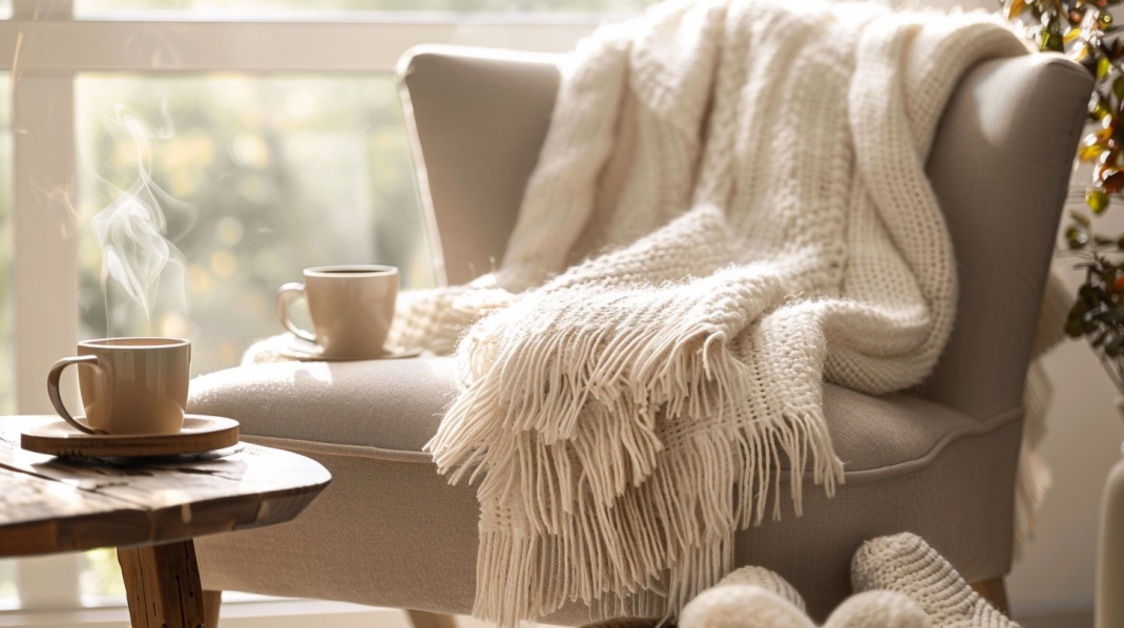
Alpaca blanket
Alpaca blankets are not only a delight for your senses but also a demonstration of sustainable textiles. The production of alpaca fiber is environmentally friendly, as alpacas tread lightly on the land, reducing soil erosion. Additionally, they consume less water and resources compared to other livestock. This sustainable aspect guarantees that your choice of an alpaca blanket supports eco-friendly practices.
These blankets are also remarkably durable. The strength of alpaca fiber rivals that of mohair, guaranteeing your blanket maintains its integrity for years. With natural resistance to dust mites and moisture, alpaca blankets are both practical and luxurious. By choosing alpaca, you’re investing in a sophisticated, sustainable, and soft addition to your home.
Silk Blankets
Why choose silk blankets for your bedding needs? Silk blankets offer unparalleled luxury and comfort due to their unique properties. Composed of natural protein fibers, silk is renowned for its smooth texture and hypoallergenic qualities, making it ideal for sensitive skin. The silk benefits extend to thermal regulation; silk naturally adjusts to your body temperature, providing warmth in the winter and a cooling effect in the summer. This adaptability guarantees year-round comfort and can contribute to improved sleep quality.
When it comes to silk care, you’ll want to pay attention to a few specifics to maintain your blanket’s beauty and longevity. Silk is a delicate material that requires gentle handling. Opt for hand washing or a delicate machine cycle using mild detergent specifically designed for silk.
Additionally, silk’s inherent resistance to dust mites and mold makes it a practical choice for allergy sufferers. Its breathable nature also reduces moisture buildup, further enhancing hygiene. Investing in a silk blanket brings elegance and functionality to your bedding ensemble, enhancing both comfort and style.
Cotton Blankets
Cotton blankets consistently offer a comfortable and versatile option for your bedding needs. With an array of cotton types available, you can select a blanket that perfectly aligns with your comfort preferences and environmental concerns. Cotton’s natural fibers breathe well, providing both warmth and ventilation, making it suitable for year-round use. Let’s explore the benefits and types of cotton that contribute to its softness and durability:
- Egyptian Cotton: Known for its extra-long fibers, this type provides unparalleled softness and strength, guaranteeing your blanket remains plush and long-lasting.
- Organic Cotton: Produced without harmful chemicals, organic cotton blankets are an eco-friendly choice, offering softness while being gentle on the skin.
- Pima Cotton: Similar to Egyptian cotton, Pima boasts long fibers that enhance softness and reduce pilling, maintaining the blanket’s smooth texture over time.
- Supima Cotton: A trademarked variety of Pima, Supima offers superior fiber strength and softness, making it a premium choice for those seeking luxury.
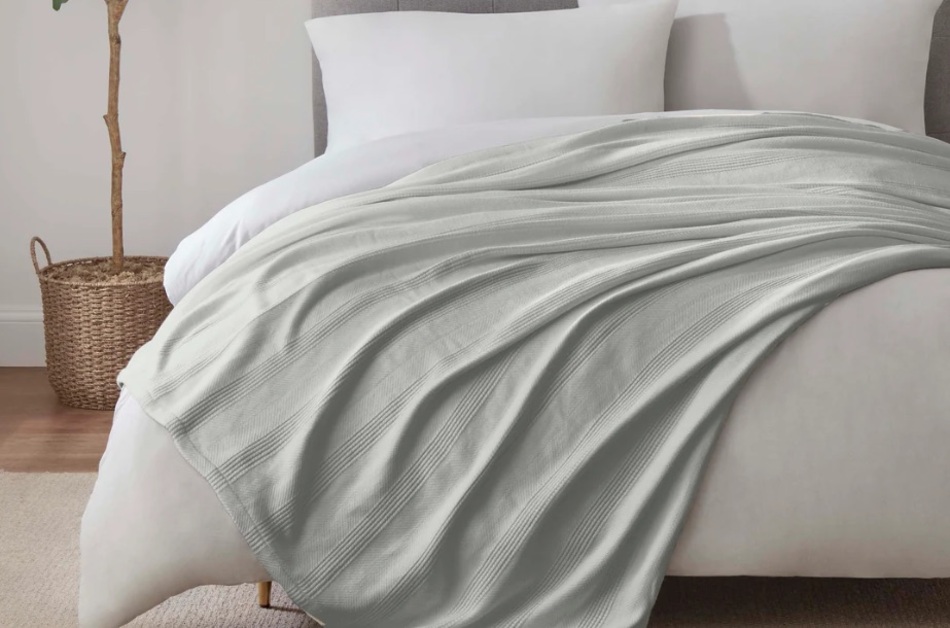
Cotton blanket fabric
These cotton benefits extend beyond mere comfort. Cotton blankets are hypoallergenic, making them ideal for allergy sufferers. They’re also easy to care for, as they withstand regular washing without losing their softness or structure. Selecting the right cotton type guarantees you experience maximum comfort and longevity.
Final Words from Yes That Blanket
When you’re choosing the softest blanket material, cashmere often takes the crown, boasting fibers that are six times finer than human hair, providing unmatched luxury. While fleece, microfiber, and other materials like Sherpa and bamboo offer impressive plushness, cashmere’s unique blend of elegance and warmth sets it apart. Imagine wrapping yourself in a material that’s both featherlight and insulating, making it perfect for cozy evenings. Ultimately, your choice hinges on desired softness, aesthetic appeal, and budget.
Frequently Asked Questions
How Do I Care for a Blanket to Maintain Its Softness?
To maintain blanket softness, wash it using a gentle cycle with cold water. Use minimal fabric softeners, as they can build up and reduce softness. Always air-dry or use low heat to prevent fiber damage and shrinkage.
What are Common Allergens in Blanket Materials?
Imagine allergen sources lurking like gremlins in blanket materials. Wool, feathers, and synthetic fibers are notorious culprits. Dust mites and dander accumulate, triggering allergic reactions. Choose hypoallergenic options to reduce exposure and maintain a restful, sneeze-free slumber.
Are Softer Blankets More Prone to Pilling?
Softer blankets can indeed be more prone to pilling due to their delicate fibers. You can enhance fabric durability by choosing tightly woven textiles and practicing pilling prevention through gentle washing techniques and avoiding high-friction environments.
How Does Blanket Softness Affect Sleep Quality?
You experience enhanced sleep comfort with softer blankets, as they reduce friction against the skin. The material comparison shows fabrics like fleece and microfiber excel in thermoregulation, ensuring warmth without overheating, vital for maintaining ideal sleep quality.
Can I Find Hypoallergenic Options Among Soft Blanket Materials?
Yes, you can find hypoallergenic options among soft blanket types. Look for hypoallergenic fabrics like bamboo, organic cotton, and microfiber. These materials combine softness with allergen resistance, ensuring comfort while minimizing allergic reactions during sleep.




